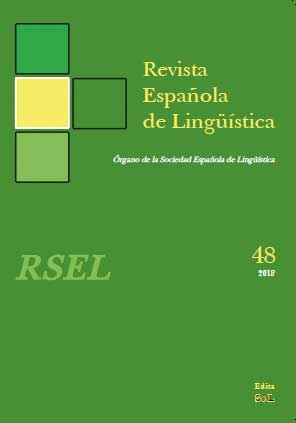Disjoint reference effect in passive constructions with ser and estar
doi: http://doi.org/0.31810/RSEL.48.6
Keywords:
ser; estar; passives; argument structure; reflexive readings.Abstract
This paper studies the disjoint reference effect in passive constructions with ser and estar ‘to be’, which consists in the impossibility of having a reflexive reading. I show, based on an empirical study undertaken with speakers of Peninsular Spanish, that said effect holds in passives with ser, but not with estar. I develop a theoretical proposal to account for the data. My study contributes to a more comprehensive understanding of the properties of passive participles with ser and estar in Spanish, as well as to the current study of verbal and adjectival passives in other languages.
Downloads
References
Alarcos Llorach, E. (1970): Estudios de gramática funcional del español, Madrid, Gredos.
Alexiadou, A., Gehrke, B. y Schäfer, F. (2014): «The argument structure of adjectival participles revisited», Lingua 149, pp. 118-138.
Anagnostopoulou, E. (2003): «Participles and voice», en Alexiadou, A., Rathert, M., y von Stechow, A. (eds.), Perfect explorations, Berlín, Mouton de Gruyter, pp. 1-36.
Arad, M. (1998): VP Structure and the Syntax-Lexicon interface, Tesis doctoral, UCL. Baker, M., Johnson, K., y Roberts, I. (1989): «Passive arguments raised», Linguistic Inquiry 20, 2, pp. 219-51.
Bosque, I. (1990): «Sobre el aspecto en los adjetivos y en los participios», en Bosque, I. (ed.), Tiempo y aspecto en español, Madrid, Cátedra, pp. 177-214.
Bruening, B. 2014. «Word formation is syntactic: adjectival passives in English», Natural Language and Linguistic Theory 32, pp. 363-422.
—, (2013): «By-Phrases in passives and nominals», Syntax 16, pp. 1-41.
Bull, W. (1965): Spanish for teachers, Nueva York, Ronald Press.
Carrasco, F. (1973): «Sobre el formante de la voz pasiva en español», RSEL 3, 2, pp. 333-341.
Conti Jiménez, C. (2004): «Construcciones pasivas con estar», ELUA 18, pp. 21-44.
Criado del Val, M. (1975): Gramática Española y comentario de textos, Madrid, Saeta.
Doron, Edit (2013): «The interaction of adjectival passive and voice», en Borer, H., Alexiadou, A. y Schäfer, F. (eds.), The roots of syntax and the syntax of roots, Oxford, Oxford University Press, pp. 164-191.
Fábregas, A. y Marín, R. (2017): «On non-dynamic eventive verbs in Spanish», Linguistics 55, 3, pp. 451-488.
Fernández-Ramírez, S. (1951): Gramática española. El verbo y la oración, Vol. 4, Madrid, Arco Libros.
García Pardo, A. (2017): «Aspect and argument structure in adjectival passives», Borealis: An International Journal of Hispanic Linguistics 6, 1, pp. 21-52.
Gómez Torrego, L. (1988): Perífrasis verbales, Madrid, Arco Libros.
Hallman, P. (2013): «Predication and movement in passive», Lingua 125, pp. 76-94.
Harley, H. (2013): «External arguments and the Mirror Principle: On the distinctness of Voice and v», Lingua 125, pp. 34-57.
Hengeveld, K. (1986): «Copular verbs in a functional grammar of Spanish», Linguistics 24, pp. 393-420.
Hernández Alonso, C. (1982): Lengua Española II, Madrid, UNED.
Kratzer, A. (1996): «Severing the external argument from the verb», en Rooryck, J. y Zaring, L. (eds.), Phrase structure and the Lexicon, Dordrecht, Kluwer, pp. 109-137.
—, (2000): «Building statives», en Conathan, L., Good, J., Kavitskaya, D., Wulf, Alyssa, B., y Yu, A. (eds.), Proceedings of the 26 Meeting of the Berkeley Linguistics Society, Berkeley, Berkeley Linguistics Society, pp. 385-399.
—, (2002): The event argument, Ms., University of Massachusetts.
Marcos Marín, F. (1980): Curso de gramática española, Madrid, Cincel.
Marín, R. (2000): El componente aspectual de la predicación, Tesis doctoral, UAB.
McIntyre A. (2013): «Adjectival passives and adjectival participles in English», en Alexiadou, A y Schäfer, F. (eds.), Non-Canonical passives, Ámsterdam, John Benjamins, pp. 21-42.
Mendikoetxea, A. (1999): «Construcciones inacusativas y pasivas», en Bosque, I. y Demonte, V. (eds.), Gramática descriptiva de la lengua española, vol. 2, Madrid, Real Academia Española/Espasa Calpe, pp. 1575-1630.
Navas-Ruiz, R. (1987): Usos de ser y estar, Madrid, Sociedad Española de Librería.
—, (1977): Ser y estar: El sistema atributivo del español, Salamanca, Almar.
Pylkkänen, L. (2000): «On stativity and causation», en Tenny, C., y Pustejovsky, J. (eds.), Events as grammatical objects: The converging perspectives of lexical semantics and syntax, CSLI Publications, pp. 417-445.
Ramchand, Gillian C. (2008): Verb meaning and the lexicon: A first phase syntax, Cambridge, Cambridge University Press.
Spathas, G., Alexiadou, A, y Schäfer, F. (2015): «Middle voice and reflexive interpretations: Afto-Prefixation in Greek», Natural Language and Linguistic Theory 33, 4, pp. 1293-1350.
Published
How to Cite
Issue
Section
Copyright (c) 2018 Revista Española de Lingüística

This work is licensed under a Creative Commons Attribution-NonCommercial 4.0 International License.











